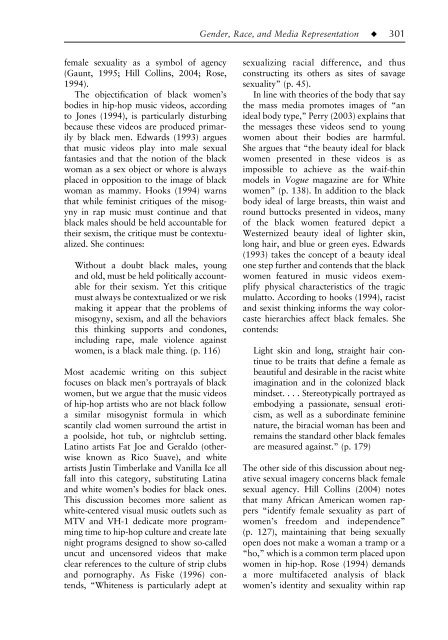Gender, race, and media representation - afghan
Gender, race, and media representation - afghan
Gender, race, and media representation - afghan
Create successful ePaper yourself
Turn your PDF publications into a flip-book with our unique Google optimized e-Paper software.
16-Dow-4973.qxd 6/11/2006 1:42 PM Page 301<br />
female sexuality as a symbol of agency<br />
(Gaunt, 1995; Hill Collins, 2004; Rose,<br />
1994).<br />
The objectification of black women’s<br />
bodies in hip-hop music videos, according<br />
to Jones (1994), is particularly disturbing<br />
because these videos are produced primarily<br />
by black men. Edwards (1993) argues<br />
that music videos play into male sexual<br />
fantasies <strong>and</strong> that the notion of the black<br />
woman as a sex object or whore is always<br />
placed in opposition to the image of black<br />
woman as mammy. Hooks (1994) warns<br />
that while feminist critiques of the misogyny<br />
in rap music must continue <strong>and</strong> that<br />
black males should be held accountable for<br />
their sexism, the critique must be contextualized.<br />
She continues:<br />
Without a doubt black males, young<br />
<strong>and</strong> old, must be held politically accountable<br />
for their sexism. Yet this critique<br />
must always be contextualized or we risk<br />
making it appear that the problems of<br />
misogyny, sexism, <strong>and</strong> all the behaviors<br />
this thinking supports <strong>and</strong> condones,<br />
including rape, male violence against<br />
women, is a black male thing. (p. 116)<br />
Most academic writing on this subject<br />
focuses on black men’s portrayals of black<br />
women, but we argue that the music videos<br />
of hip-hop artists who are not black follow<br />
a similar misogynist formula in which<br />
scantily clad women surround the artist in<br />
a poolside, hot tub, or nightclub setting.<br />
Latino artists Fat Joe <strong>and</strong> Geraldo (otherwise<br />
known as Rico Suave), <strong>and</strong> white<br />
artists Justin Timberlake <strong>and</strong> Vanilla Ice all<br />
fall into this category, substituting Latina<br />
<strong>and</strong> white women’s bodies for black ones.<br />
This discussion becomes more salient as<br />
white-centered visual music outlets such as<br />
MTV <strong>and</strong> VH-1 dedicate more programming<br />
time to hip-hop culture <strong>and</strong> create late<br />
night programs designed to show so-called<br />
uncut <strong>and</strong> uncensored videos that make<br />
clear references to the culture of strip clubs<br />
<strong>and</strong> pornography. As Fiske (1996) contends,<br />
“Whiteness is particularly adept at<br />
<strong>Gender</strong>, Race, <strong>and</strong> Media Representation–––◆–––301<br />
sexualizing racial difference, <strong>and</strong> thus<br />
constructing its others as sites of savage<br />
sexuality” (p. 45).<br />
In line with theories of the body that say<br />
the mass <strong>media</strong> promotes images of “an<br />
ideal body type,” Perry (2003) explains that<br />
the messages these videos send to young<br />
women about their bodies are harmful.<br />
She argues that “the beauty ideal for black<br />
women presented in these videos is as<br />
impossible to achieve as the waif-thin<br />
models in Vogue magazine are for White<br />
women” (p. 138). In addition to the black<br />
body ideal of large breasts, thin waist <strong>and</strong><br />
round buttocks presented in videos, many<br />
of the black women featured depict a<br />
Westernized beauty ideal of lighter skin,<br />
long hair, <strong>and</strong> blue or green eyes. Edwards<br />
(1993) takes the concept of a beauty ideal<br />
one step further <strong>and</strong> contends that the black<br />
women featured in music videos exemplify<br />
physical characteristics of the tragic<br />
mulatto. According to hooks (1994), racist<br />
<strong>and</strong> sexist thinking informs the way colorcaste<br />
hierarchies affect black females. She<br />
contends:<br />
Light skin <strong>and</strong> long, straight hair continue<br />
to be traits that define a female as<br />
beautiful <strong>and</strong> desirable in the racist white<br />
imagination <strong>and</strong> in the colonized black<br />
mindset. . . . Stereotypically portrayed as<br />
embodying a passionate, sensual eroticism,<br />
as well as a subordinate feminine<br />
nature, the biracial woman has been <strong>and</strong><br />
remains the st<strong>and</strong>ard other black females<br />
are measured against.” (p. 179)<br />
The other side of this discussion about negative<br />
sexual imagery concerns black female<br />
sexual agency. Hill Collins (2004) notes<br />
that many African American women rappers<br />
“identify female sexuality as part of<br />
women’s freedom <strong>and</strong> independence”<br />
(p. 127), maintaining that being sexually<br />
open does not make a woman a tramp or a<br />
“ho,” which is a common term placed upon<br />
women in hip-hop. Rose (1994) dem<strong>and</strong>s<br />
a more multifaceted analysis of black<br />
women’s identity <strong>and</strong> sexuality within rap




